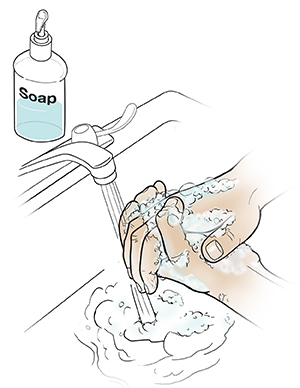Wound Care
Taking good care of your wound will help it heal. Your healthcare provider may show you how to clean and dress the wound. They will also explain how to tell if the wound is healing normally. If you are unsure of how to take care of the wound, ask what dressing to use and how often you should change the bandages. Below are the basic steps.
Wash your hands

Tips for washing your hands:
-
Use liquid soap and lather. Scrub for 20 seconds between your fingers and under your nails.
-
Rinse with clean, running water, keeping your fingers pointed down.
-
Use a paper towel to dry your hands and to turn off the faucet.
Remove the used dressing
Here are suggestions for removing the dressing:
-
If dressing changes cause you pain, take your pain medicine as prescribed by your healthcare provider 30 minutes before dressing changes.
-
Set up your supplies.
-
Put on disposable gloves if you’re dressing a wound for someone else or your wound is infected.
-
Loosen the tape by pulling gently toward the wound.
-
Gently take off the old dressing. If the dressing is stuck to the wound, moisten it with saline (if available) or clean water.
-
If you have a drain or tube in the wound, be careful not to pull on it.
-
Remove the dressing 1 layer at a time and put it in a plastic bag. Seal the bag and put it in the trash.
-
Remove your gloves.
Inspect and dress the wound
Check the wound carefully:
-
Each time you change the dressing, check the wound carefully to be sure it’s healing normally. Check that your wound appears to be pink and moist and that it's free of infection.
-
Wash your hands again. Put on a new pair of gloves.
-
Clean and dress the wound as directed by your healthcare provider or nurse. Don't put anything in the wound that is not prescribed or directed by your healthcare provider. If you have a drain or tube, be careful not to pull on it. Secure the drain or tube as well.
-
Put all unused supplies in a clean plastic bag. Seal the bag and store it in a clean, dry area between dressing changes.
-
Wash your hands again.
Call your healthcare provider
Call your healthcare provider if you see any of the following signs of a problem:
-
Bleeding that soaks the dressing
-
Pink fluid weeping from the wound
-
Increased drainage or drainage that is white, yellow, yellow-green, or foul-smelling
-
Increased swelling or pain, or redness or swelling in the skin around the wound
-
A change in the color of the wound, or if streaks develop in a direction away from the wound
-
The area between any stitches opens up
-
An increase in the size of the wound
-
A fever of 100.4°F (38°C) or higher, or as directed by your healthcare provider
-
Chills, increased fatigue, or a loss of appetite
Online Medical Reviewer:
Jonas DeMuro MD
Online Medical Reviewer:
Raymond Turley Jr PA-C
Online Medical Reviewer:
Tara Novick BSN MSN
Date Last Reviewed:
10/1/2022
© 2000-2024 The StayWell Company, LLC. All rights reserved. This information is not intended as a substitute for professional medical care. Always follow your healthcare professional's instructions.